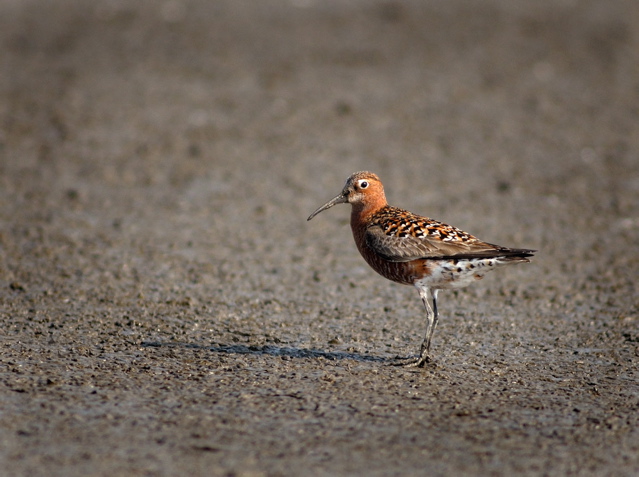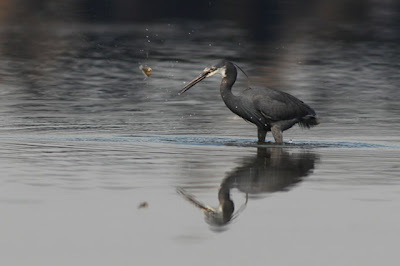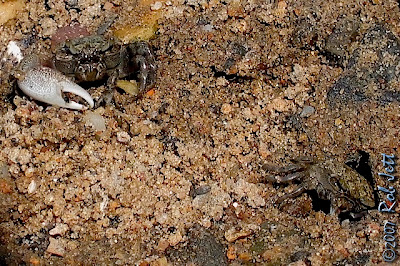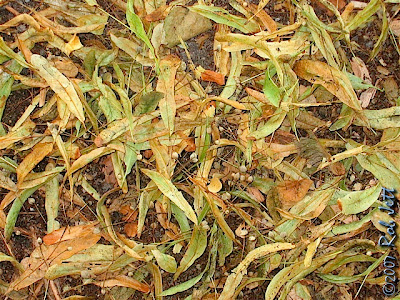Coney Island Creek & Jamaica Bay Wildlife Refuge
Saturday, July 25th It seems incredible, but so far this year, a considerable number of New York birders have observed the following "unusual" species, without having to leave the state:
It seems incredible, but so far this year, a considerable number of New York birders have observed the following "unusual" species, without having to leave the state:
(click for range maps)
Western Tanager
Smith's Longspur
Ivory Gull
Mew Gull
White-faced Ibis
Arctic Tern
Yellow-headed Blackbird
Western Reef Heron
As of this week, there is another out of town visitor to add to the list - Curlew Sandpiper. The sandpiper was found at the East Pond of Jamaica Bay Wildlife Refuge. Some species have already begun their southbound migration and rangers have lowered the water level on the East Pond to create mud-flats for the hungry, long distance travelers. The pond is a magnet for plovers, sandpipers, yellowlegs, dowitchers, godwits and many other species known collectively as shorebirds. A majority of these birds breed in the far north or tundra. The Curlew Sandpiper typically breeds in northern Siberia. One theory as to how the rare vagrants end up on the east coast of the United States is that they take a shortcut over the top, so to speak.
A pair of Curlew Sandpipers showed up at Cape May earlier in the year and Sean drove down to photograph them. Even so, he still wanted to check out the one at Jamaica Bay and asked me to join him. His brother, David, would meet us at the parking lot. He also wanted to look for the Western Reef Heron at Coney Island Creek to take some more photos. The heron is still around but occasionally disappears for stretches of time. In the shallow water just offshore, there are the rotting, wooden skeletons of several old barges. Black-crowned Night-Herons like to roost on the vertical ribs and we speculated that, when the reef heron cannot be located, he is possibly hidden from view within the recesses of the old wrecks. The sun had been up for about an hour when we arrived at the creek. Sean parked behind the Home Depot, which brought us farther east into the creek than during our last visit. It is beyond a bend in the creek from where the bird spends most of his time. Doug once found the reef heron behind Home Depot when others were unable to locate him. From that point, we walked down the shore towards the narrow channel on the east side of Calvert Vaux Park (the park previously known as Dreier-Offerman Park). At low tide, an exposed mud-flat in the channel attracts several species of wading birds and shorebirds, not just the Western Reef Heron.
The sun had been up for about an hour when we arrived at the creek. Sean parked behind the Home Depot, which brought us farther east into the creek than during our last visit. It is beyond a bend in the creek from where the bird spends most of his time. Doug once found the reef heron behind Home Depot when others were unable to locate him. From that point, we walked down the shore towards the narrow channel on the east side of Calvert Vaux Park (the park previously known as Dreier-Offerman Park). At low tide, an exposed mud-flat in the channel attracts several species of wading birds and shorebirds, not just the Western Reef Heron.
The heron was not present and Sean did not want to spend a lot of time looking as his primary objective was to meet up with David and find the Curlew Sandpiper. I did not mind because having begun my day in the calm stillness along the creek was a fair consolation. Etched in my brain is the impression of rosy, early morning sun illuminating decaying, hulking masses of weather-sculpted timber. Hunched over and sleepy, red-eyed night-herons were resting on wood monoliths, looking as though they had just returned home after an evening of drunken debauchery. Finding and grasping a fleeting moment of repose in the dissonance of city life is golden. The Curlew Sandpiper was reportedly feeding with some dowitchers near the north end of the East Pond. Access to the north end is via a vehicle restricted gravel road, which leads to a narrow swath cut though a seemingly impenetrable jungle of phragmites. Rubber "Wellies" are essential footwear as the trail leads out onto a mud-flat where, if you are not observant, a wrong step could put you into thigh-deep muck.
The Curlew Sandpiper was reportedly feeding with some dowitchers near the north end of the East Pond. Access to the north end is via a vehicle restricted gravel road, which leads to a narrow swath cut though a seemingly impenetrable jungle of phragmites. Rubber "Wellies" are essential footwear as the trail leads out onto a mud-flat where, if you are not observant, a wrong step could put you into thigh-deep muck.
We walked south, towards the sandpiper's last known whereabouts, hugging the edge of the phragmites. A few feet to our left were scattered patches of hidden mud traps. Least Sandpipers and Semipalmated Plover probed the pungent, insect-rich mud close to the wall of reeds. Small groups of Short-billed Dowitchers fed in shallow water. Interspersed throughout the pond’s receding water were Greater Yellowlegs, Lesser Yellowlegs, Stilt Sandpiper, Pectoral Sandpiper and Semipalmated Sandpiper. A single American Oystercatcher broadcast his presence with emphatic, whistled “wheeps”. We set up our tripods near a midpoint on the west side of the pond. Earlier we had seen a raccoon at the edge of the water in that spot. From there we had a clear view of both sides, from “The Raunt” to our right and Sanderling Point and North Island to our left. For two and a half hours, we scanned from north to south and combed through ever bird in sight. Patches of pink Swamp-rose Mallow on the far shore added a nice visual break to the monotony of a wall of green phragmites. An “A” train was parked on the tracks that are parallel to the pond and on the opposite side of the phragmites. Periodically, the hydraulic breaks would release pressure, emitting a loud, hissing pop that triggered flocks of shorebirds into a flying frenzy. We would use the opportunity to scan for the Curlew Sandpiper in the flocks that passed in front of us. Never having seen one, I repeatedly asked Sean if it was possible for me to overlook. Finally, he replied, “Just look for a flying brick”.
We set up our tripods near a midpoint on the west side of the pond. Earlier we had seen a raccoon at the edge of the water in that spot. From there we had a clear view of both sides, from “The Raunt” to our right and Sanderling Point and North Island to our left. For two and a half hours, we scanned from north to south and combed through ever bird in sight. Patches of pink Swamp-rose Mallow on the far shore added a nice visual break to the monotony of a wall of green phragmites. An “A” train was parked on the tracks that are parallel to the pond and on the opposite side of the phragmites. Periodically, the hydraulic breaks would release pressure, emitting a loud, hissing pop that triggered flocks of shorebirds into a flying frenzy. We would use the opportunity to scan for the Curlew Sandpiper in the flocks that passed in front of us. Never having seen one, I repeatedly asked Sean if it was possible for me to overlook. Finally, he replied, “Just look for a flying brick”.
 Last year we watched helplessly as a photographer attempted to cross from east to west at the northern end of the pond. He ended up waist-deep in the mud and unable to free himself. Eventually, Ed Coyle and another birder carried some large pieces of driftwood down the east trail, built a boardwalk and pulled him from the muck. There is a warning sign at that spot, so he should not have even attempted the crossing. I didn’t see any warning signs in the middle of the pond so I decided to try and walk directly across to the east side. Sean and David looked at me as if I was crazy. I picked my steps carefully, made it to the center of the pond, and stopped on a sandbar. The water was never more that about six inches deep. From there, I enjoyed the shorebird’s perspective of the pond and watched a flock of Barn Swallows swooping all around me. Ahead of me, a thick matt of algae covered the water and, in open areas, the water appeared dark and deep. I turned around and went back the way I came.
Last year we watched helplessly as a photographer attempted to cross from east to west at the northern end of the pond. He ended up waist-deep in the mud and unable to free himself. Eventually, Ed Coyle and another birder carried some large pieces of driftwood down the east trail, built a boardwalk and pulled him from the muck. There is a warning sign at that spot, so he should not have even attempted the crossing. I didn’t see any warning signs in the middle of the pond so I decided to try and walk directly across to the east side. Sean and David looked at me as if I was crazy. I picked my steps carefully, made it to the center of the pond, and stopped on a sandbar. The water was never more that about six inches deep. From there, I enjoyed the shorebird’s perspective of the pond and watched a flock of Barn Swallows swooping all around me. Ahead of me, a thick matt of algae covered the water and, in open areas, the water appeared dark and deep. I turned around and went back the way I came. Sean had walked back towards Sanderling Point and was sitting on the ground with his camera. David suddenly picked up his scope and hurried in the direction of his brother. My cellphone rang just as I stepped back on to the shore and started in their direction. It was Sean, and in a hushed voice, said two words, “Found it.” He was not exaggerating when he explained that I could not miss the bird. The sandpiper’s plumage had begun the transition to dull winter colors, but was still mostly a deep, chestnut-red. In addition to his striking color, black legs and a long, thin decurved bill created a unique profile among our expected shorebirds. Our vigilance had paid off, but I could not figure out how we overlooked him. Sean said that he was photographing a Stilt Sandpiper when the curlew just appeared in his frame. It is possible that he was always present, but just blocked from view by the larger, rounder dowitchers. For thirty minutes, we watched him walk back and forth in a small area several yards offshore, picking insects from the water. By 11AM, we decided to pack up our gear and get an early lunch.
Sean had walked back towards Sanderling Point and was sitting on the ground with his camera. David suddenly picked up his scope and hurried in the direction of his brother. My cellphone rang just as I stepped back on to the shore and started in their direction. It was Sean, and in a hushed voice, said two words, “Found it.” He was not exaggerating when he explained that I could not miss the bird. The sandpiper’s plumage had begun the transition to dull winter colors, but was still mostly a deep, chestnut-red. In addition to his striking color, black legs and a long, thin decurved bill created a unique profile among our expected shorebirds. Our vigilance had paid off, but I could not figure out how we overlooked him. Sean said that he was photographing a Stilt Sandpiper when the curlew just appeared in his frame. It is possible that he was always present, but just blocked from view by the larger, rounder dowitchers. For thirty minutes, we watched him walk back and forth in a small area several yards offshore, picking insects from the water. By 11AM, we decided to pack up our gear and get an early lunch. On our way back to the trail, David pointed out an insect on the ground and asked if it was a Mayfly. As we looked, Sean pointed out another one. A quick scan revealed that they were all over the place. I sat down in the mud for a close look and was surprised to see that they were tiny dragonflies. We were probably in the midst of a mass emergence of the unidentified dragonflies. The event was good for the shorebirds, bad for the slow dragonflies.
On our way back to the trail, David pointed out an insect on the ground and asked if it was a Mayfly. As we looked, Sean pointed out another one. A quick scan revealed that they were all over the place. I sat down in the mud for a close look and was surprised to see that they were tiny dragonflies. We were probably in the midst of a mass emergence of the unidentified dragonflies. The event was good for the shorebirds, bad for the slow dragonflies.I used to say (partly in jest) that there was always “one more bird” before going home. Each day it seems like I learn a little more about my surroundings, maybe I should change the word “bird” to “species” or “thing”.
Day List:
Coney Island Creek & Jamaica Bay Wildlife Refuge (East Pond only), 7/25/2007


Great Blue Heron
Great Egret
Snowy Egret
Green Heron
Black-crowned Night-Heron
Glossy Ibis
Osprey
Peregrine Falcon
Semipalmated Plover
American Oystercatcher
Greater Yellowlegs
Lesser Yellowlegs
Semipalmated Sandpiper
Least Sandpiper
Pectoral Sandpiper
Stilt Sandpiper
Short-billed Dowitcher
Laughing Gull
Great Black-backed Gull
Common Tern
Forster's Tern
Least Tern
Chimney Swift
Belted Kingfisher
Willow Flycatcher
Eastern Kingbird
Fish Crow
Tree Swallow
Bank Swallow
Barn Swallow
Carolina Wren
Gray Catbird
Northern Mockingbird
Cedar Waxwing
Yellow Warbler
Common Yellowthroat
Eastern Towhee
Boat-tailed Grackle
Other common species seen (or heard):
Double-crested Cormorant, Canada Goose, Mute Swan, American Black Duck, Mallard, Herring Gull, Rock Pigeon, Mourning Dove, American Robin, European Starling, Northern Cardinal, Song Sparrow, Red-winged Blackbird, House Sparrow
























































